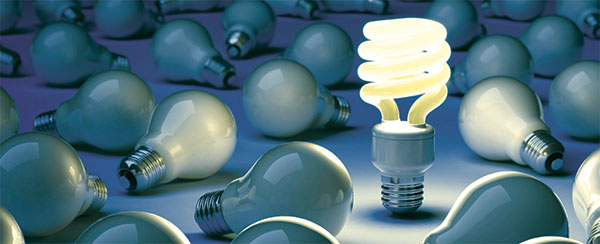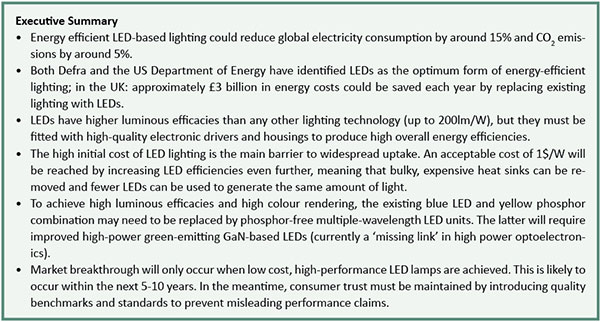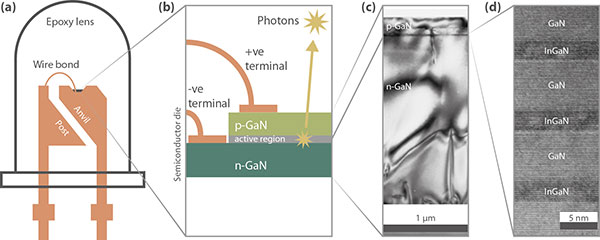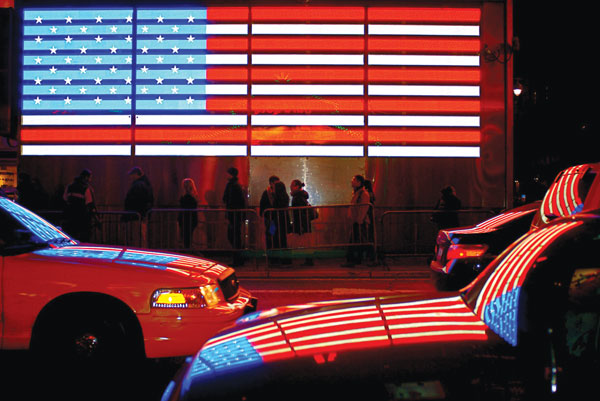New Light Emitting Diode (LED) technology offers significant promise for reducing the wasteful energy usage associated with lighting and display applications. An ultimate reduction of up to 15% of the total electricity consumption in developed countries could be achieved if LEDs were to replace existing forms of household, commercial and street lighting. This would be achieved not only because of the increased luminous efficacy of LED light sources, but also by increasing the power factor of the entire lighting unit and by introducing control systems that take advantage of the long-lasting, fully dimmable nature of LEDs. However, the high cost of LED-based lighting is the main barrier to widespread consumer uptake today.
This article outlines routes towards improved performance and lower costs, both for LEDs and for the ‘luminaire’ units they are built into. Because LED lighting can offer additional benefits not offered by current technology, such as their application in indoors wireless data transfer, commercial breakthrough will be driven initially by demand for niche applications. Long-term, however, low-cost LED lighting technology developed with the aid of new materials is likely to play a significant role in the reduction of energy demand both in the developed and the developing world.
The need to reduce unnecessary energy consumption is widely acknowledged in the developed world: as a result, carbon emissions associated with electricity generation and fossil fuel consumption are the subject of increasing regulation. The UK Climate Change Act 2008 has set a legally binding target of a 34% cut in CO2 emissions by 2020 and an 80% cut by 2050, compared to 1990 levels, while the EU is aiming for a similar reduction of 20% by 2020. Electricity generation is currently the single biggest anthropogenic source of CO2, so a reduction in electricity consumption will need to be achieved in order to meet these goals.
Worldwide, approximately 20% of electricity is used by lighting and this proportion is predicted to rise by 80 % by 2030
Worldwide, approximately 20% of electricity is used by lighting and this proportion is predicted to rise by 80% by 2030, as it is estimated that approximately 1.5 billion people in developing countries do not yet have access to electric lighting. For the purposes of comparison, CO2 emissions from lighting are approximately three times greater than total emissions from aviation worldwide.

Lighting, Energy and Waste
Globally, a low proportion of our electricity supply comes from ‘clean’ sources, and this is not expected to change significantly within the next ten years. Consequently, the use of improved light sources could reduce our CO2 emissions by 5% or more over the next decade alone – a significant amount for just one technological area. Furthermore, lighting is one of the few areas in which a reduction in energy usage can be achieved without impacting performance, so consumers could realistically be expected to purchase and use the new technology. These key advantages make lighting a primary target for reducing energy demand in the developed world.
Lighting is one of the few areas in which a reduction in energy usage can be achieved without impacting performance
However, the energy needs of the developing world must also be addressed. Although the per capita use of energy in developing nations is low compared to that of the developed world, their total energy usage is growing rapidly and has considerable scope for increase far beyond current demands. The challenge of managing sustainable growth is considerable, and is already the subject of concern for the emerging economies of China and India. Indeed, at the moment, 30 times more energy is used for lighting per person in the USA than in India, indicating the scale of the latent demand in developing countries.
In this regard, lighting has an important role to play. Reliability and consistency of home, office and street lighting services are an essential enabler of economic growth and development, and it is not realistic to try to limit their use. However, a reduction in wasted energy by lighting applications can have a significant impact on the development of energy infrastructure. For example, the Chinese government has recently made a very substantial multi-million pound investment into manufacturing facilities for the production of energy-efficient LEDs, with the aim of reducing energy demand, instead of funding more coal-fired power stations.

Looking towards the least developed countries, it is also possible to see how advances in energy-efficient lighting technology could assist progress towards meeting the Millennium Development Goals, which include a commitment to the provision of universal education for all children up to primary level, plus a target to improve environmental sustainability and the quality of life for the very poorest. One example involves the use of LED-based energy efficient lighting to enable children in developing countries to complete schoolwork at night. Reliable lighting would be important for a wide range of developing countries, as electricity supplies can be highly intermittent even if a family is nominally connected to their local supply. However, much research still needs to be done in order to increase the efficiencies and reduce the costs of semiconductor LEDs to the point at which they are affordable.
Much research still needs to be done in order to increase the efficiencies and reduce the costs of semiconductor LEDs to the point at which they are affordable
Energy Efficiency
The very first step in developing better LED technology is to understand what efficiency really means. The ability of our eyes to detect light varies substantially, depending on the wavelength of the light. As a result, a simple efficiency measure (e.g. the light output power for a given electrical input power) is of little use. Instead, we need to consider how much of that light will be detected by the human eye: this is called the luminous efficacy of the light source or lighting system. As our retinas are most sensitive to green light, the best possible light source would emit at this wavelength. However, to produce white light, we need to combine light of at least two different, complementary colours. Consequently, a maximum luminous efficacy can be reached by choosing pairs of wavelengths that remain relatively close, but this comes at a cost: most objects won’t reflect light of these wavelengths, leading to poor colour rendering. A compromise must therefore be reached, in which the aim of high efficacy is balanced by the requirement for acceptable colour rendering. Overall, for a given colour rendering value, we can increase the luminous efficacy by improving any of the components of a typical lighting unit: a light source, a luminaire (or light fixture) which houses the light source with its associated reflectors, electrical circuitry and power connection, and control systems including switches and/or sensors.

The table summarises the main lighting technologies currently in use: their luminous efficacies vary widely. From all of the high-performance lighting technologies, fluorescent lamps already operate close to their maximum efficacy, but LEDs emerge as the most promising lighting technology. The figure shows the construction of a typical LED, on which white lighting is based. Most white LEDs, including the recent record-breaking 200lm/W device, now use the combination of a blue LED and a phosphor, which converts some of the blue light into red, yellow and/or green light. However, the most efficient approach is to combine LEDs of three or four individual colours, avoiding the significant energy losses associated with using phosphors. Research nevertheless still needs to be enhanced, as we do not yet have efficient green-emitting LEDs that work well at high operating powers. Improvements in this area are essential to reduce waste in lighting applications in both the developed and the developing world.
Although efficacy figures are often quoted for a light source alone, in reality a valid comparison can only be made between light sources incorporated into fixtures, which can contain electronic drivers or ‘ballast’ and which may also include light-reflecting and heat-dissipating structures. However, even though some efficiency losses will occur in the driver electronics, their high power factor and efficient direction of light means that a well-designed 10W LED lamp can already provide approximately equivalent lighting to a 100W incandescent bulb, a 30W compact fluorescent lamp, a 20W linear fluorescent lamp or a 20W metal halide discharge lamp. This is particularly important in the developing world, in which the only available source of power may be a battery, capable only of driving low power devices.
In the developed world, significant energy savings can already be made by switching from incandescent lamps to high-voltage linear fluorescent lamps. However, fluorescent lights are not dimmable and usually reach their peak performance only after a warm-up period of several minutes, while their lifetimes are reduced significantly by frequent switching. In contrast, LEDs can be switched frequently and are easily dimmable, allowing the use of lighting management systems which adapt to external light levels and maintain a minimum level of illumination. By reducing usage, control systems in buildings could cut the energy consumption of LED lighting systems by a further 50%, representing a 95% overall reduction in energy usage compared to incandescent lamps and a 75% reduction compared to linear fluorescent lamps.

A common objection is that increasing the energy efficiency of an appliance could lead to additional wasteful use, particularly in the developed world. However, near-continuous lighting is essential to almost everyone, so there is little room left for careless growth in consumption due to this ‘moral hazard’ on the part of individuals. Consequently, there is little reason to expect the savings due to increased lighting efficiency to be counteracted by an increase in wasteful use. However, other factors are also vital to ensure that the promise of high efficiencies and significant energy savings is realised.
The Economics
Here in the UK, a recent Department for Environment, Food and Rural Affairs (Defra) report highlighted LEDs as the most promising form of energy-efficient lighting technology, as did the USA’s Department of Energy. A very recent US DOE report estimates that over $20 billion in annual electricity savings would result if high-efficiency LEDs were introduced widely in the US. A closer look at the amount of electricity used for lighting reveals that consumption in the UK is shared between the commercial (70%), residential (26%) and street lighting (4%) sectors, according to recent Defra estimates. Even though linear fluorescent lamps are already widely used commercially and compact fluorescent lamps are used in about 20% of domestic settings, a comparable figure for the energy savings associated with introducing LED lighting to the UK can still reach approximately £3 billion.
Of course, these savings can only be made if consumers can be persuaded to purchase and use LED lighting. Although regulation can be used to force consumers to do so, such moves tend to be unpopular and politically risky. Economic factors will inevitably dominate consumers’ purchasing decisions, and these are influenced strongly by the initial purchase price, which is why cheap incandescent bulbs still comprise around 80% of global sales by volume. Although rising energy costs will tend to promote the uptake of LEDs over less efficient forms of lighting, LED lighting units currently need to be at least 5 times cheaper (ideally 10 times cheaper) than existing alternatives in order to become competitive, as indicated by the $/lm values given in the table. Obviously, cost minimisation is also of vital importance for the developing world.
LED lighting units currently need to be at least 5 times cheaper ... than existing alternatives in order to become competitive
To reach the goals of cost minimisation (and hence better energy savings in the real world), we need to focus on the $/lm figure of merit. It can be increased by improving performance (more lumens of light per $) or by reducing costs (each lumen of light costs less): fortunately, significant gains in $/lm values can easily be made through technological improvements. At the moment, the major limiting factor is the efficiency with which electricity can be converted to light within the LED chip, especially at high operating currents. Ultra-high efficiencies of 90% or more will maximise the lumen output for a given chip size and will also reduce waste heat production, resulting in greater reliability, longer lamp lifetimes, reduced fire risks and dramatically reduced heat sink costs. Importantly though, such high LED efficiencies would need to be achieved routinely for large volumes of chips to meet demand from lamp manufacturers. This means that increases in chip efficiencies must also be accompanied by higher yields, achieved primarily through increased wafer uniformity and high-throughput production techniques (e.g. large-area substrates and thinner, rapidly fabricated LED structures).

To really reduce costs and minimise waste, the lifetimes of lighting units also need to be maximised. The usable lifetimes of the best LEDs can reach 100,000 hours when tested in isolation, and these values are often quoted by manufacturers as the lifetime of the entire lamp assembly. In reality, the latter will be limited by the lifetime of other heat-sensitive components, which can be as little as 5,000 hours. Consequently, clear testing and labelling standards have been brought in within the USA: similar moves should be made as a matter of urgency in Europe.
LEDs of the Future
Few competing technologies exist, meaning that conventional LEDs are likely to retain their position as the leading energy-efficient lighting technology well into the future. Indeed, we estimate that world LED production already stands at about 100,000 million (1011) units per year, with projected annual growth rates of at least 10% over the next decade: manufacturing capacity is therefore sufficient to supply the world’s needs.
Further benefits are also expected: research aimed towards increasing the efficiencies of LEDs emitting in the visible region should also result in more efficient ultraviolet-emitting LEDs, which could lead to improvements in water treatment applications and hence offer hope to those who currently lack access to clean water.
Such efforts are well worth making – on a global scale, cheap and efficient LED lighting should promote sustainable development, reduce wasteful CO2 emissions and reduce our dependence on limited fossil fuel reserves.








